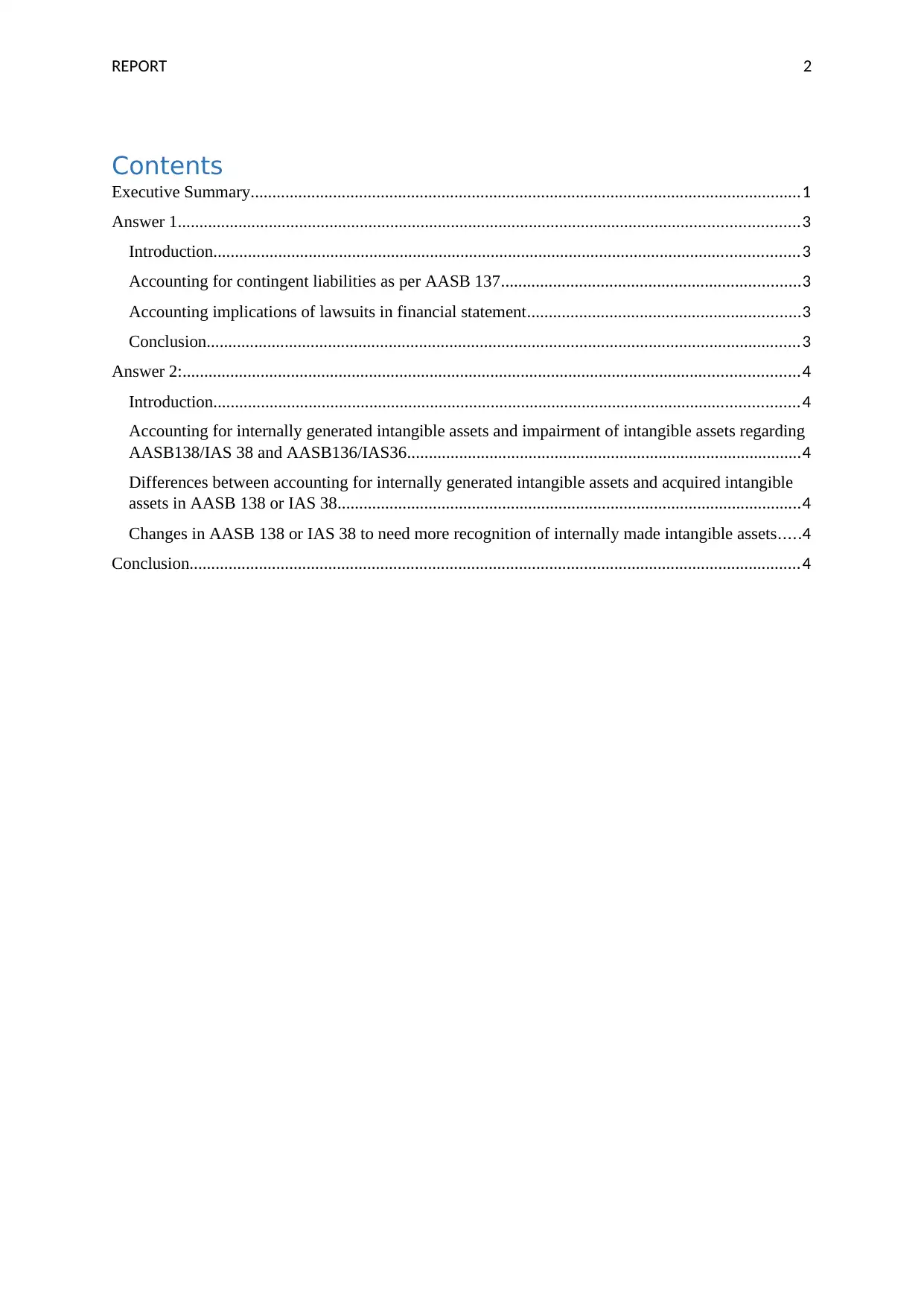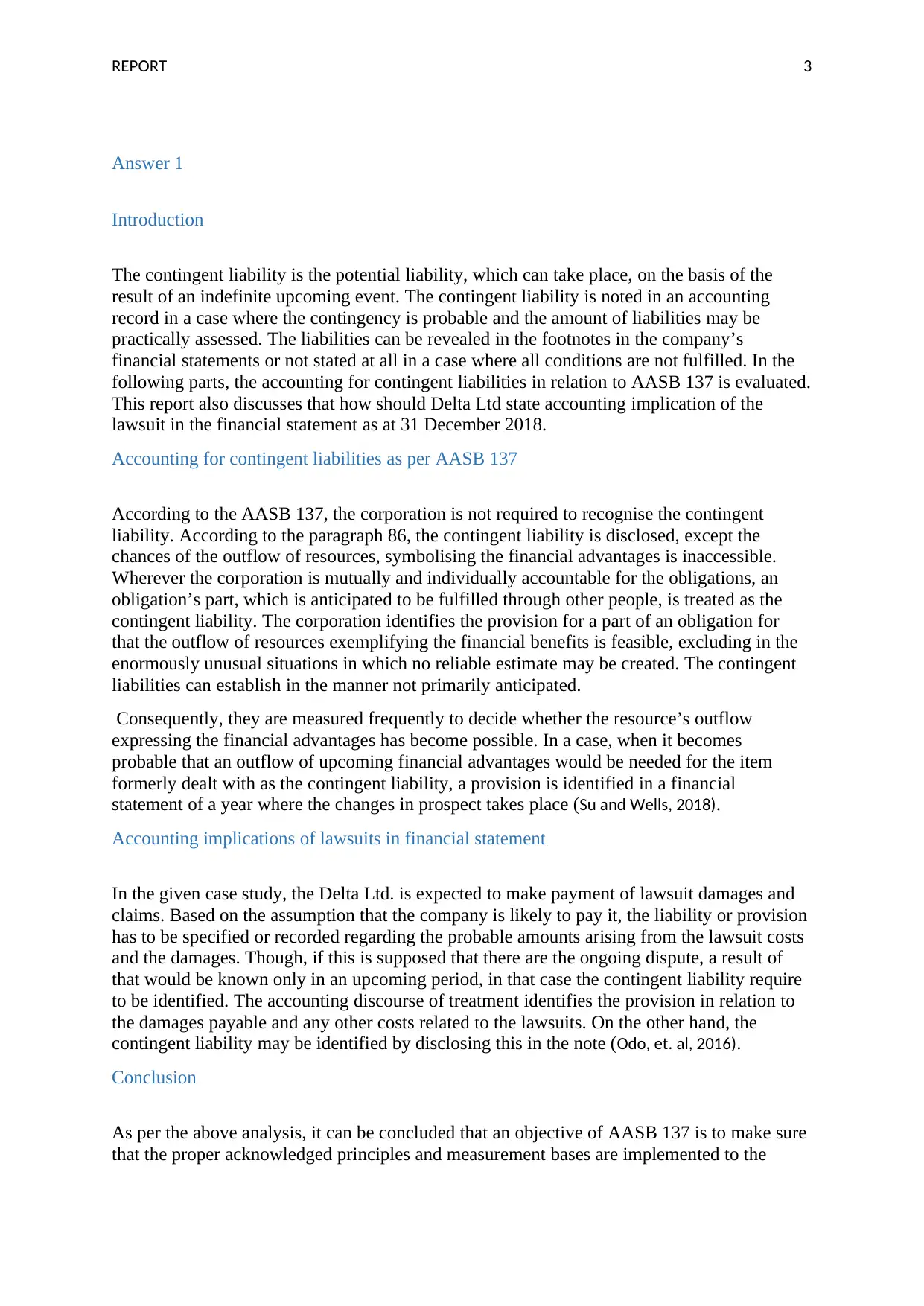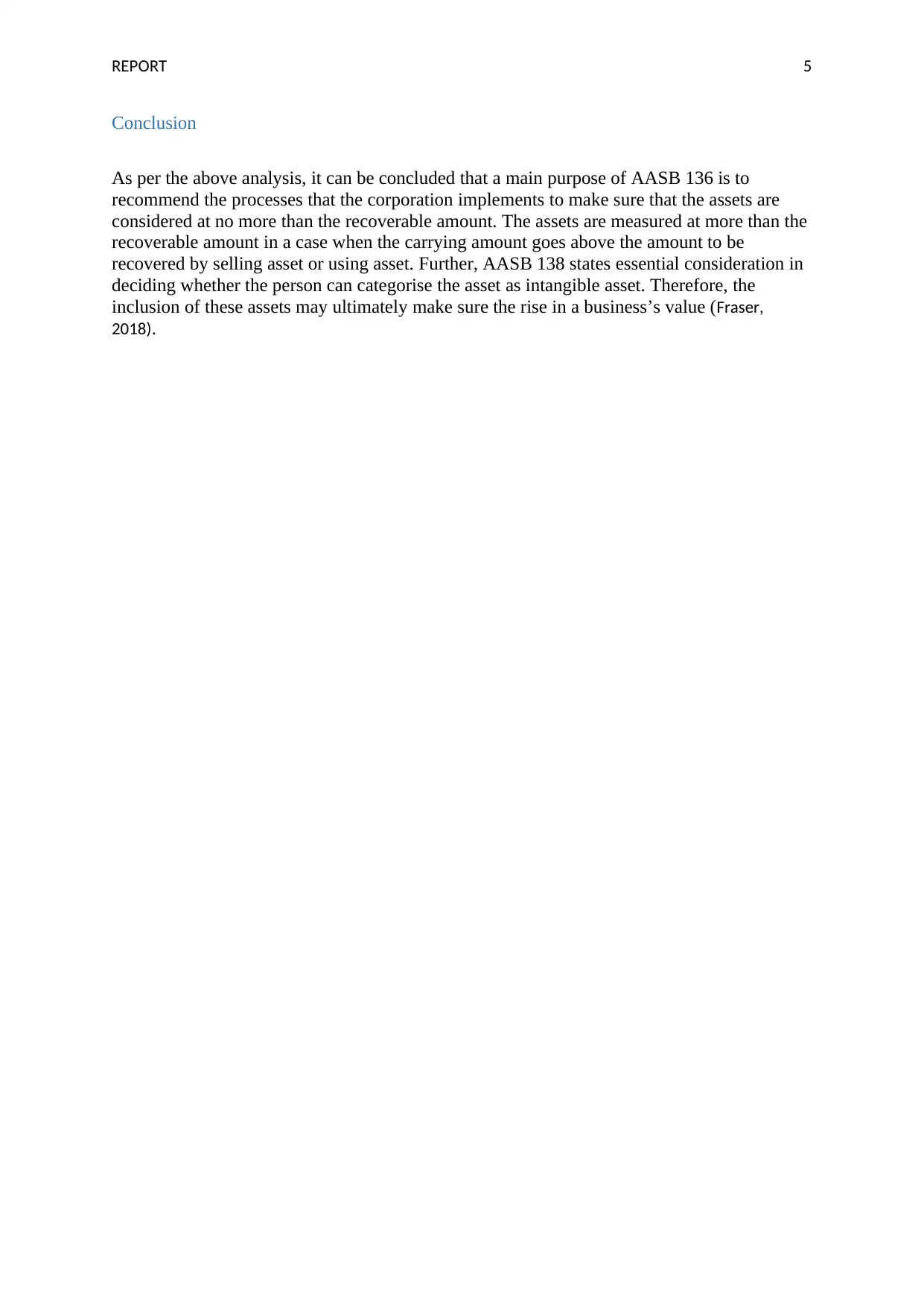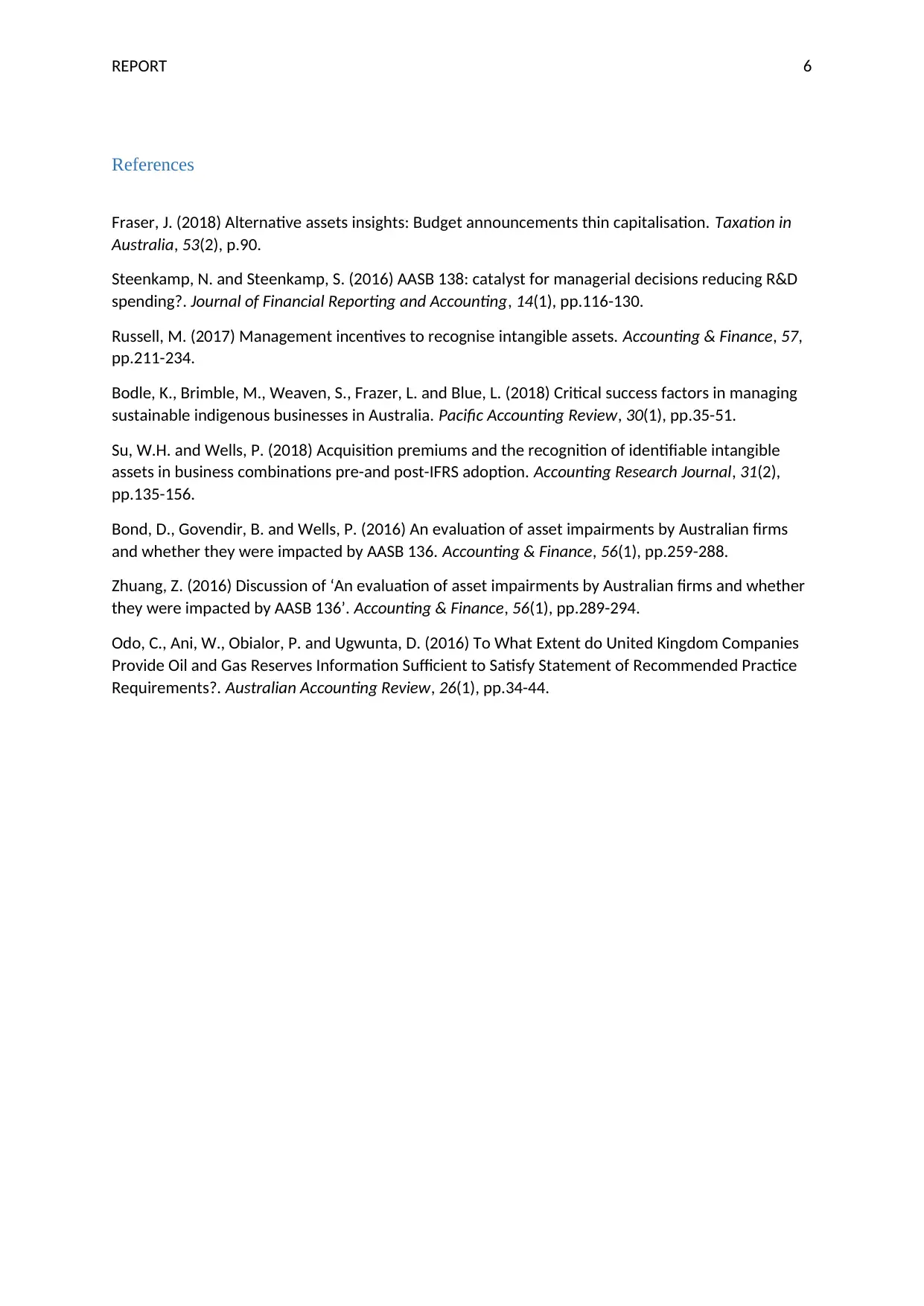Financial Accounting and Reporting: AASB 137 and AASB 138 Analysis
VerifiedAdded on 2022/10/18
|7
|1682
|318
Report
AI Summary
This report provides an analysis of financial accounting standards, specifically focusing on AASB 137 and AASB 138/IAS 36. The first part of the report examines accounting for contingent liabilities as per AASB 137 and its implications for lawsuits, determining how Delta Ltd. should state accounting implications of a lawsuit in its financial statements. The second part delves into AASB 138/IAS 38, exploring the accounting for internally generated intangible assets and the impairment of intangible assets. It highlights the differences between internally generated and acquired intangible assets and discusses potential changes to the standards to improve recognition of internally made intangible assets. The report concludes with a summary of key findings and references relevant literature.

Running heads: REPORT 0
FINANCIAL ACCOUNTING AND REPORTING
MAY 25, 2019
STUDENT DETAILS:
FINANCIAL ACCOUNTING AND REPORTING
MAY 25, 2019
STUDENT DETAILS:
Paraphrase This Document
Need a fresh take? Get an instant paraphrase of this document with our AI Paraphraser

REPORT 1
Executive Summary
The information stated by financial statements in compliance with accounting standard makes
sure the transparency of the businesses. The AASB 138/IAS 38 addresses the procedure to
identify the intangible asset, as well as the procedure assess the intangible assets. This
standard also sets out the needs for disclosing the intangible asset. On the other hand,
AASB 136/IAS 36 ‘Impairment of Assets’ includes IAS 36 ‘Impairment of Assets’ addressed
by the International Accounting Standards Board. Australian-specific paragraphs (that are
not covered in IAS 36) are recognised with a prefix ‘Aus’. Paragraph that is applicable only
on the not-for-profit organisations create by recognising the limited applicability.
Executive Summary
The information stated by financial statements in compliance with accounting standard makes
sure the transparency of the businesses. The AASB 138/IAS 38 addresses the procedure to
identify the intangible asset, as well as the procedure assess the intangible assets. This
standard also sets out the needs for disclosing the intangible asset. On the other hand,
AASB 136/IAS 36 ‘Impairment of Assets’ includes IAS 36 ‘Impairment of Assets’ addressed
by the International Accounting Standards Board. Australian-specific paragraphs (that are
not covered in IAS 36) are recognised with a prefix ‘Aus’. Paragraph that is applicable only
on the not-for-profit organisations create by recognising the limited applicability.

REPORT 2
Contents
Executive Summary...............................................................................................................................1
Answer 1...............................................................................................................................................3
Introduction.......................................................................................................................................3
Accounting for contingent liabilities as per AASB 137.....................................................................3
Accounting implications of lawsuits in financial statement...............................................................3
Conclusion.........................................................................................................................................3
Answer 2:..............................................................................................................................................4
Introduction.......................................................................................................................................4
Accounting for internally generated intangible assets and impairment of intangible assets regarding
AASB138/IAS 38 and AASB136/IAS36...........................................................................................4
Differences between accounting for internally generated intangible assets and acquired intangible
assets in AASB 138 or IAS 38...........................................................................................................4
Changes in AASB 138 or IAS 38 to need more recognition of internally made intangible assets.....4
Conclusion.............................................................................................................................................4
Contents
Executive Summary...............................................................................................................................1
Answer 1...............................................................................................................................................3
Introduction.......................................................................................................................................3
Accounting for contingent liabilities as per AASB 137.....................................................................3
Accounting implications of lawsuits in financial statement...............................................................3
Conclusion.........................................................................................................................................3
Answer 2:..............................................................................................................................................4
Introduction.......................................................................................................................................4
Accounting for internally generated intangible assets and impairment of intangible assets regarding
AASB138/IAS 38 and AASB136/IAS36...........................................................................................4
Differences between accounting for internally generated intangible assets and acquired intangible
assets in AASB 138 or IAS 38...........................................................................................................4
Changes in AASB 138 or IAS 38 to need more recognition of internally made intangible assets.....4
Conclusion.............................................................................................................................................4
⊘ This is a preview!⊘
Do you want full access?
Subscribe today to unlock all pages.

Trusted by 1+ million students worldwide

REPORT 3
Answer 1
Introduction
The contingent liability is the potential liability, which can take place, on the basis of the
result of an indefinite upcoming event. The contingent liability is noted in an accounting
record in a case where the contingency is probable and the amount of liabilities may be
practically assessed. The liabilities can be revealed in the footnotes in the company’s
financial statements or not stated at all in a case where all conditions are not fulfilled. In the
following parts, the accounting for contingent liabilities in relation to AASB 137 is evaluated.
This report also discusses that how should Delta Ltd state accounting implication of the
lawsuit in the financial statement as at 31 December 2018.
Accounting for contingent liabilities as per AASB 137
According to the AASB 137, the corporation is not required to recognise the contingent
liability. According to the paragraph 86, the contingent liability is disclosed, except the
chances of the outflow of resources, symbolising the financial advantages is inaccessible.
Wherever the corporation is mutually and individually accountable for the obligations, an
obligation’s part, which is anticipated to be fulfilled through other people, is treated as the
contingent liability. The corporation identifies the provision for a part of an obligation for
that the outflow of resources exemplifying the financial benefits is feasible, excluding in the
enormously unusual situations in which no reliable estimate may be created. The contingent
liabilities can establish in the manner not primarily anticipated.
Consequently, they are measured frequently to decide whether the resource’s outflow
expressing the financial advantages has become possible. In a case, when it becomes
probable that an outflow of upcoming financial advantages would be needed for the item
formerly dealt with as the contingent liability, a provision is identified in a financial
statement of a year where the changes in prospect takes place (Su and Wells, 2018).
Accounting implications of lawsuits in financial statement
In the given case study, the Delta Ltd. is expected to make payment of lawsuit damages and
claims. Based on the assumption that the company is likely to pay it, the liability or provision
has to be specified or recorded regarding the probable amounts arising from the lawsuit costs
and the damages. Though, if this is supposed that there are the ongoing dispute, a result of
that would be known only in an upcoming period, in that case the contingent liability require
to be identified. The accounting discourse of treatment identifies the provision in relation to
the damages payable and any other costs related to the lawsuits. On the other hand, the
contingent liability may be identified by disclosing this in the note (Odo, et. al, 2016).
Conclusion
As per the above analysis, it can be concluded that an objective of AASB 137 is to make sure
that the proper acknowledged principles and measurement bases are implemented to the
Answer 1
Introduction
The contingent liability is the potential liability, which can take place, on the basis of the
result of an indefinite upcoming event. The contingent liability is noted in an accounting
record in a case where the contingency is probable and the amount of liabilities may be
practically assessed. The liabilities can be revealed in the footnotes in the company’s
financial statements or not stated at all in a case where all conditions are not fulfilled. In the
following parts, the accounting for contingent liabilities in relation to AASB 137 is evaluated.
This report also discusses that how should Delta Ltd state accounting implication of the
lawsuit in the financial statement as at 31 December 2018.
Accounting for contingent liabilities as per AASB 137
According to the AASB 137, the corporation is not required to recognise the contingent
liability. According to the paragraph 86, the contingent liability is disclosed, except the
chances of the outflow of resources, symbolising the financial advantages is inaccessible.
Wherever the corporation is mutually and individually accountable for the obligations, an
obligation’s part, which is anticipated to be fulfilled through other people, is treated as the
contingent liability. The corporation identifies the provision for a part of an obligation for
that the outflow of resources exemplifying the financial benefits is feasible, excluding in the
enormously unusual situations in which no reliable estimate may be created. The contingent
liabilities can establish in the manner not primarily anticipated.
Consequently, they are measured frequently to decide whether the resource’s outflow
expressing the financial advantages has become possible. In a case, when it becomes
probable that an outflow of upcoming financial advantages would be needed for the item
formerly dealt with as the contingent liability, a provision is identified in a financial
statement of a year where the changes in prospect takes place (Su and Wells, 2018).
Accounting implications of lawsuits in financial statement
In the given case study, the Delta Ltd. is expected to make payment of lawsuit damages and
claims. Based on the assumption that the company is likely to pay it, the liability or provision
has to be specified or recorded regarding the probable amounts arising from the lawsuit costs
and the damages. Though, if this is supposed that there are the ongoing dispute, a result of
that would be known only in an upcoming period, in that case the contingent liability require
to be identified. The accounting discourse of treatment identifies the provision in relation to
the damages payable and any other costs related to the lawsuits. On the other hand, the
contingent liability may be identified by disclosing this in the note (Odo, et. al, 2016).
Conclusion
As per the above analysis, it can be concluded that an objective of AASB 137 is to make sure
that the proper acknowledged principles and measurement bases are implemented to the
Paraphrase This Document
Need a fresh take? Get an instant paraphrase of this document with our AI Paraphraser

REPORT 4
provisions, contingent assets, contingent liabilities and that proper data is stated in a note to
make able the users to understand the nature, amounts, and period.
Answer 2:
Introduction
AASB 138 states the meaning of the intangible asset. AASB 138 includes IAS 38 (Intangible
Assets) as issued by IASB (Bodle, et. al, 2018). This standard how to identify the intangible
asset, how to evaluate the intangible asset, and addresses the provisions to disclose the
intangible assets. In the following report, differences between AASB 138 and IAS 38, and
changes in AASB 138 and IAS 38 is discussed and examined.
Accounting for internally generated intangible assets and impairment of intangible assets
regarding AASB138/IAS 38 and AASB136/IAS36
As per the AASB 138, it is required to measure the asset through the costs. After identifying
the assets as intangible per elements in AASB 138, one can assess these assets by either the
cost theory or revaluation theory. Specifics of all the models are stated in AASB 138. This
standard needs to disclose the data for every class of the intangible asset.
Further, IAS 136 recognises the recoverable amount as higher of the fair value of CGU or
assets less disposal cost and the value in use. Paragraphs 19–57 state provisions for assessing
the recoverable amount (Russell, 2017).
Differences between accounting for internally generated intangible assets and acquired
intangible assets in AASB 138 or IAS 38
This is very simple identifiable intangible while they are purchased comparing to while they
are within made. For purchased intangibles, there are the market transactions and purchased
assets are assessed at the cost evaluated at FV for business’s combination. For assets acquired
in a business combination fair values can be utilised in comparison of having to know the
cost. With purchased asset, the asset restricted in para 63 for identification as internally made
intangible, can be identified. When identified, the intangible asset is consequently treated the
similar (Steenkamp and Steenkamp, 2016).
Changes in AASB 138 or IAS 38 to need more recognition of internally made intangible
assets
The manager prefers to inflate upcoming benefits. Wherever main investment in R&D are
written off, it is the assurance that the prospective revenues and incomes derived from the
purchase would be reported creative through the main expenditure item, the intangible asset’s
amortisation. The effect over ratio like rate of return on equity as well as asset are best in an
upcoming period if write-off occurs now in place of the periodic amortisation in future. The
investor normally considers write-off as one-period item, of no concern for the asset’s
valuation. The number of great hits is considered better than episodic amortisation (Zhuang,
2016).
provisions, contingent assets, contingent liabilities and that proper data is stated in a note to
make able the users to understand the nature, amounts, and period.
Answer 2:
Introduction
AASB 138 states the meaning of the intangible asset. AASB 138 includes IAS 38 (Intangible
Assets) as issued by IASB (Bodle, et. al, 2018). This standard how to identify the intangible
asset, how to evaluate the intangible asset, and addresses the provisions to disclose the
intangible assets. In the following report, differences between AASB 138 and IAS 38, and
changes in AASB 138 and IAS 38 is discussed and examined.
Accounting for internally generated intangible assets and impairment of intangible assets
regarding AASB138/IAS 38 and AASB136/IAS36
As per the AASB 138, it is required to measure the asset through the costs. After identifying
the assets as intangible per elements in AASB 138, one can assess these assets by either the
cost theory or revaluation theory. Specifics of all the models are stated in AASB 138. This
standard needs to disclose the data for every class of the intangible asset.
Further, IAS 136 recognises the recoverable amount as higher of the fair value of CGU or
assets less disposal cost and the value in use. Paragraphs 19–57 state provisions for assessing
the recoverable amount (Russell, 2017).
Differences between accounting for internally generated intangible assets and acquired
intangible assets in AASB 138 or IAS 38
This is very simple identifiable intangible while they are purchased comparing to while they
are within made. For purchased intangibles, there are the market transactions and purchased
assets are assessed at the cost evaluated at FV for business’s combination. For assets acquired
in a business combination fair values can be utilised in comparison of having to know the
cost. With purchased asset, the asset restricted in para 63 for identification as internally made
intangible, can be identified. When identified, the intangible asset is consequently treated the
similar (Steenkamp and Steenkamp, 2016).
Changes in AASB 138 or IAS 38 to need more recognition of internally made intangible
assets
The manager prefers to inflate upcoming benefits. Wherever main investment in R&D are
written off, it is the assurance that the prospective revenues and incomes derived from the
purchase would be reported creative through the main expenditure item, the intangible asset’s
amortisation. The effect over ratio like rate of return on equity as well as asset are best in an
upcoming period if write-off occurs now in place of the periodic amortisation in future. The
investor normally considers write-off as one-period item, of no concern for the asset’s
valuation. The number of great hits is considered better than episodic amortisation (Zhuang,
2016).

REPORT 5
Conclusion
As per the above analysis, it can be concluded that a main purpose of AASB 136 is to
recommend the processes that the corporation implements to make sure that the assets are
considered at no more than the recoverable amount. The assets are measured at more than the
recoverable amount in a case when the carrying amount goes above the amount to be
recovered by selling asset or using asset. Further, AASB 138 states essential consideration in
deciding whether the person can categorise the asset as intangible asset. Therefore, the
inclusion of these assets may ultimately make sure the rise in a business’s value (Fraser,
2018).
Conclusion
As per the above analysis, it can be concluded that a main purpose of AASB 136 is to
recommend the processes that the corporation implements to make sure that the assets are
considered at no more than the recoverable amount. The assets are measured at more than the
recoverable amount in a case when the carrying amount goes above the amount to be
recovered by selling asset or using asset. Further, AASB 138 states essential consideration in
deciding whether the person can categorise the asset as intangible asset. Therefore, the
inclusion of these assets may ultimately make sure the rise in a business’s value (Fraser,
2018).
⊘ This is a preview!⊘
Do you want full access?
Subscribe today to unlock all pages.

Trusted by 1+ million students worldwide

REPORT 6
References
Fraser, J. (2018) Alternative assets insights: Budget announcements thin capitalisation. Taxation in
Australia, 53(2), p.90.
Steenkamp, N. and Steenkamp, S. (2016) AASB 138: catalyst for managerial decisions reducing R&D
spending?. Journal of Financial Reporting and Accounting, 14(1), pp.116-130.
Russell, M. (2017) Management incentives to recognise intangible assets. Accounting & Finance, 57,
pp.211-234.
Bodle, K., Brimble, M., Weaven, S., Frazer, L. and Blue, L. (2018) Critical success factors in managing
sustainable indigenous businesses in Australia. Pacific Accounting Review, 30(1), pp.35-51.
Su, W.H. and Wells, P. (2018) Acquisition premiums and the recognition of identifiable intangible
assets in business combinations pre-and post-IFRS adoption. Accounting Research Journal, 31(2),
pp.135-156.
Bond, D., Govendir, B. and Wells, P. (2016) An evaluation of asset impairments by Australian firms
and whether they were impacted by AASB 136. Accounting & Finance, 56(1), pp.259-288.
Zhuang, Z. (2016) Discussion of ‘An evaluation of asset impairments by Australian firms and whether
they were impacted by AASB 136’. Accounting & Finance, 56(1), pp.289-294.
Odo, C., Ani, W., Obialor, P. and Ugwunta, D. (2016) To What Extent do United Kingdom Companies
Provide Oil and Gas Reserves Information Sufficient to Satisfy Statement of Recommended Practice
Requirements?. Australian Accounting Review, 26(1), pp.34-44.
References
Fraser, J. (2018) Alternative assets insights: Budget announcements thin capitalisation. Taxation in
Australia, 53(2), p.90.
Steenkamp, N. and Steenkamp, S. (2016) AASB 138: catalyst for managerial decisions reducing R&D
spending?. Journal of Financial Reporting and Accounting, 14(1), pp.116-130.
Russell, M. (2017) Management incentives to recognise intangible assets. Accounting & Finance, 57,
pp.211-234.
Bodle, K., Brimble, M., Weaven, S., Frazer, L. and Blue, L. (2018) Critical success factors in managing
sustainable indigenous businesses in Australia. Pacific Accounting Review, 30(1), pp.35-51.
Su, W.H. and Wells, P. (2018) Acquisition premiums and the recognition of identifiable intangible
assets in business combinations pre-and post-IFRS adoption. Accounting Research Journal, 31(2),
pp.135-156.
Bond, D., Govendir, B. and Wells, P. (2016) An evaluation of asset impairments by Australian firms
and whether they were impacted by AASB 136. Accounting & Finance, 56(1), pp.259-288.
Zhuang, Z. (2016) Discussion of ‘An evaluation of asset impairments by Australian firms and whether
they were impacted by AASB 136’. Accounting & Finance, 56(1), pp.289-294.
Odo, C., Ani, W., Obialor, P. and Ugwunta, D. (2016) To What Extent do United Kingdom Companies
Provide Oil and Gas Reserves Information Sufficient to Satisfy Statement of Recommended Practice
Requirements?. Australian Accounting Review, 26(1), pp.34-44.
1 out of 7
Related Documents
Your All-in-One AI-Powered Toolkit for Academic Success.
+13062052269
info@desklib.com
Available 24*7 on WhatsApp / Email
![[object Object]](/_next/static/media/star-bottom.7253800d.svg)
Unlock your academic potential
Copyright © 2020–2025 A2Z Services. All Rights Reserved. Developed and managed by ZUCOL.





